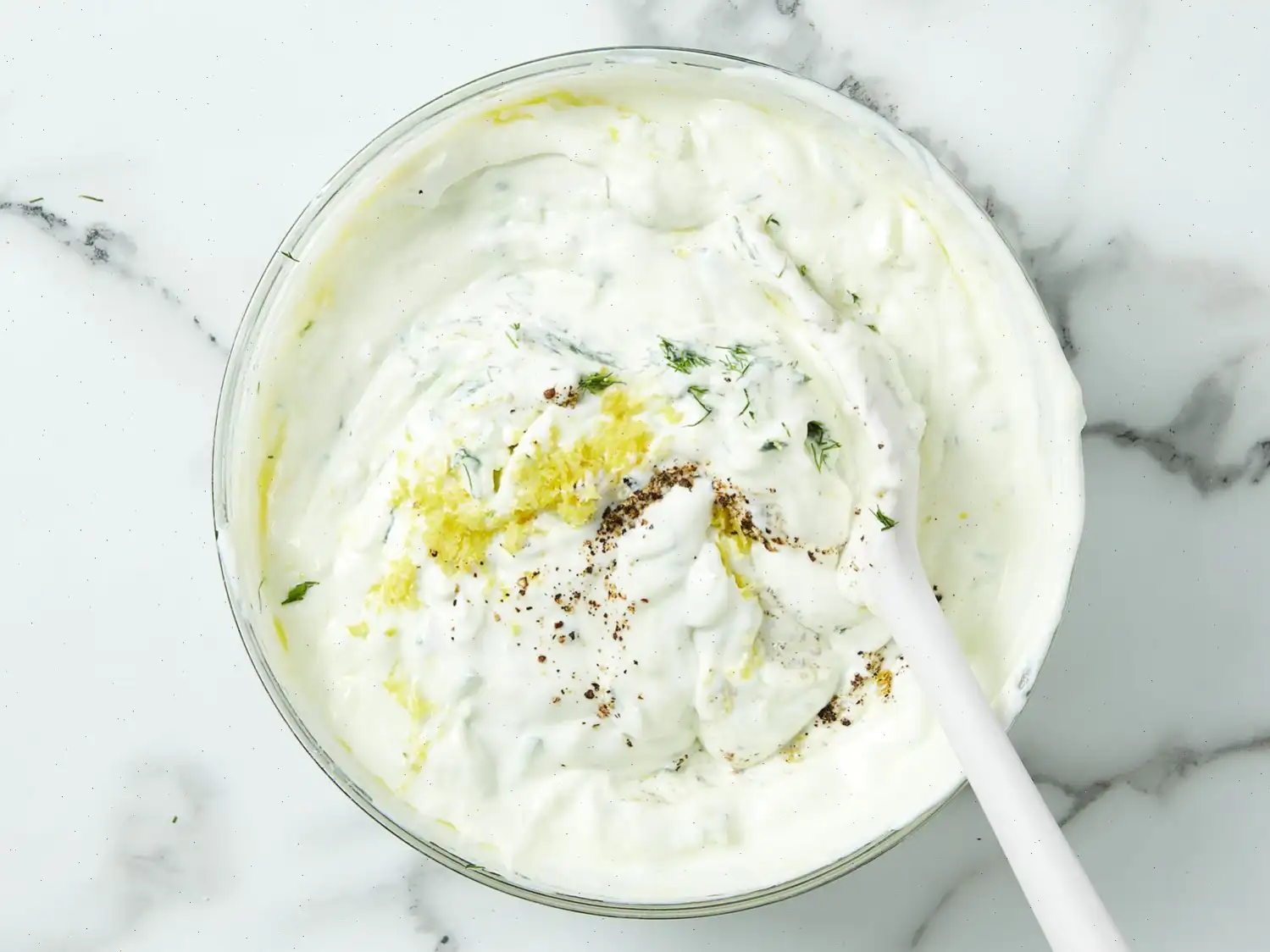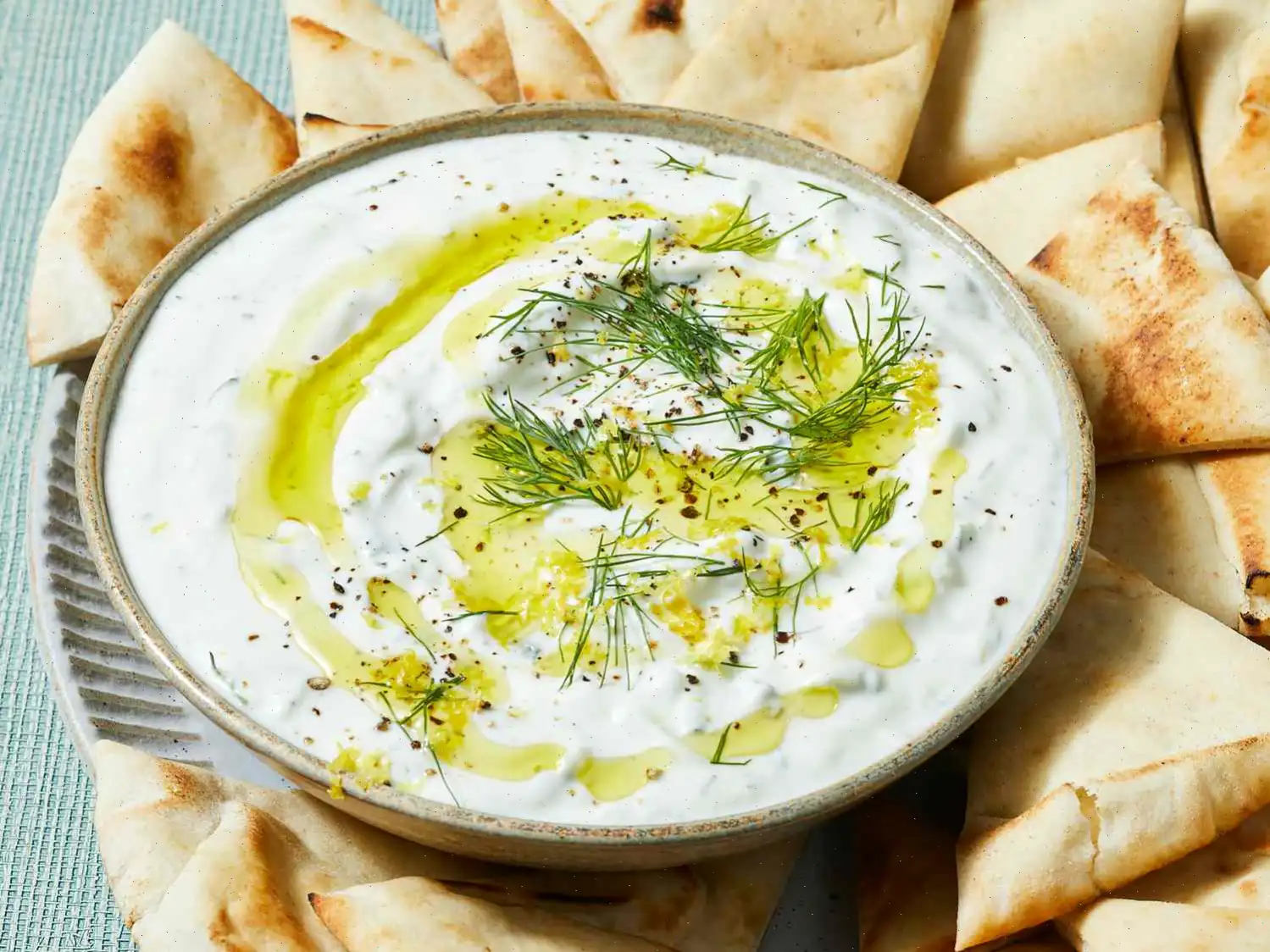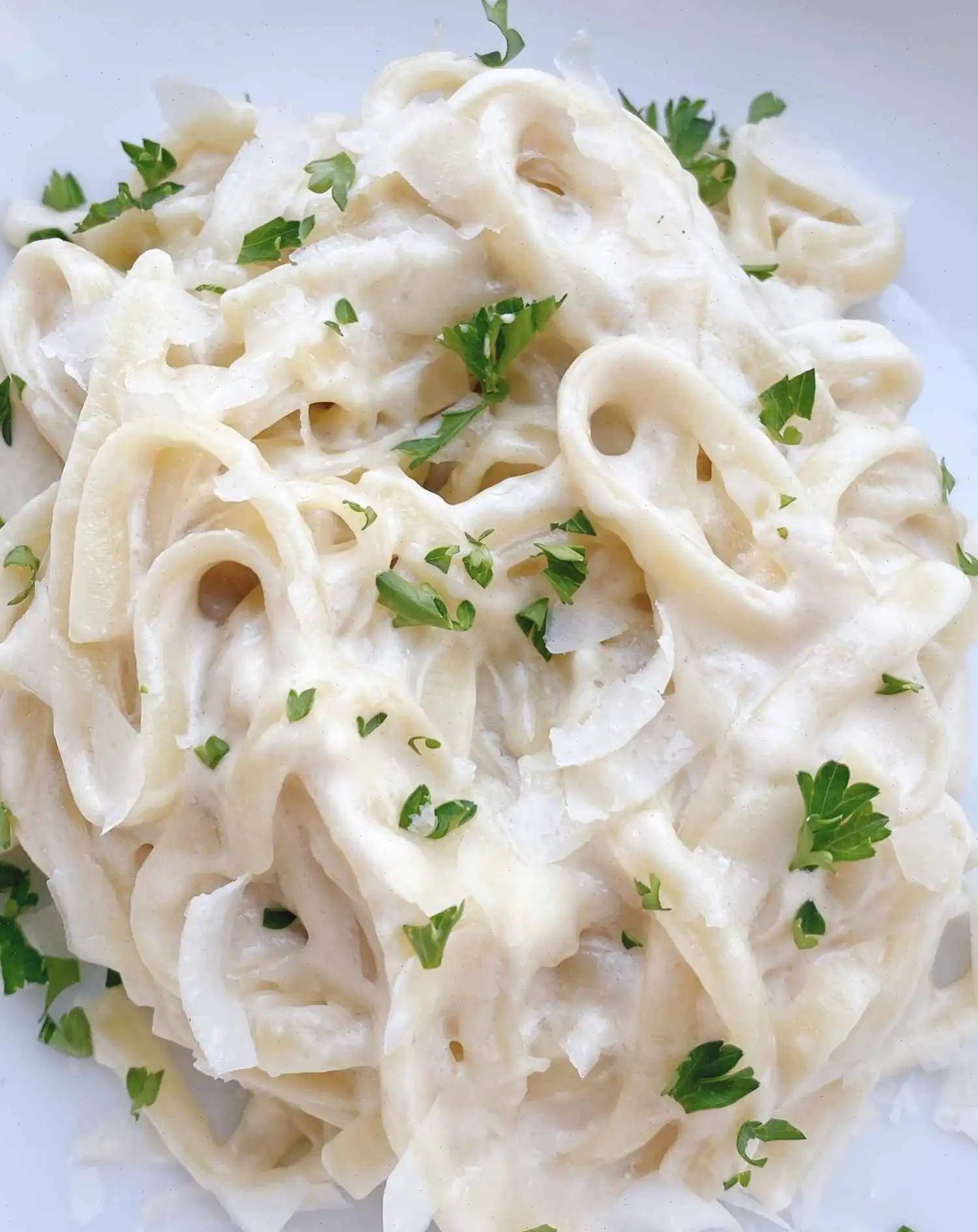
Greek Tzatziki Recipe
Ingredients:
- 1 (32 ounce) plain low-fat yogurt
- English cucumber with peel, grated
- 2 tablespoons fresh lemon juice
- 2 tablespoons extra-virgin olive oil
- 1 clove garlic, pressed
- 3 tablespoons chopped fresh dill
- 1 tablespoon salt, or to taste
- 1 tablespoon freshly ground black pepper, or to taste
- 2 teaspoons grated lemon zest
Directions:
- Gather all ingredients.
- In a large bowl, combine the yogurt, grated cucumber, lemon juice, olive oil, and garlic.
- Add the chopped dill, salt, black pepper, and grated lemon zest to the bowl. Mix everything together until smooth.
- Transfer the mixture to a serving dish and garnish with additional fresh dill.
Cook's Note: For the best flavor, cover the dish tightly and refrigerate for 8 hours before serving to allow the flavors to blend.
Nutrition Facts (per serving):
| Nutrient | Amount | % Daily Value |
|---|---|---|
| Calories | 22 | |
| Total Fat | 1g | 1% |
| Saturated Fat | 0g | 2% |
| Cholesterol | 1mg | 0% |
| Sodium | 191mg | 8% |
| Total Carbohydrate | 2g | 1% |
| Dietary Fiber | 0g | 0% |
| Total Sugars | 2g | |
| Protein | 1g | 3% |
| Vitamin C | 1mg | 1% |
| Calcium | 43mg | 3% |
| Iron | 0mg | 1% |
| Potassium | 59mg | 1% |
* Percent Daily Values are based on a 2,000 calorie diet. Your daily values may be higher or lower depending on your calorie needs.

Tzatziki is a classic Greek dip that has found its place on tables around the world. With its cool, creamy texture and tangy flavors, it pairs perfectly with grilled meats, pita bread, and vegetables. But beyond being a delicious addition to a meal, tzatziki has a rich history and offers many regional variations. Lets dive deeper into the origins and unique qualities of this beloved dish.
Origin and History
Tzatziki traces its roots back to ancient Greece and Turkey, where similar yogurt-based sauces have been made for centuries. The dish is believed to have been derived from the Turkish yogurt dip called "Cack," which has a nearly identical composition. In Greece, tzatziki became a staple of Mediterranean cuisine and evolved into the refreshing dip we know today, made with Greek yogurt, cucumbers, garlic, and herbs. Historically, it was used as a cooling accompaniment to meats like lamb, especially in warmer months.
Regional Variations
Though tzatziki is most commonly associated with Greek cuisine, the dip is popular throughout the Eastern Mediterranean and Balkans, with each region adding its own unique twist. In Turkey, the dish is often thinner and served as a side dish, while in Greece, its typically thicker, making it more suitable as a dip. In some Middle Eastern variations, tzatziki is made with additional spices such as cumin or mint, enhancing its flavor and offering a diverse range of interpretations of the base recipe.
What Sets Tzatziki Apart
While tzatziki shares similarities with other yogurt-based dips like raita from India, it stands out due to its simplicity and fresh ingredients. Unlike raita, which often incorporates fruits and a variety of spices, tzatziki focuses on the cooling combination of cucumber, garlic, and dill. Its creamy texture is achieved using thick Greek yogurt, which is rich in protein and adds a slightly tangy taste. This difference in consistency and flavor profile makes tzatziki a unique and refreshing addition to many dishes.
Where is Tzatziki Traditionally Served?
In Greece, tzatziki is often served alongside grilled meats, particularly lamb, as part of a traditional mezze platter. Its a perfect complement to the bold flavors of roasted meats or souvlaki, providing a cool contrast. Tzatziki is also commonly found in pita wraps, particularly in gyros or souvlaki sandwiches, where it helps balance the spiciness of the grilled meat. Outside of Greece, tzatziki has become popular in restaurants around the world, often paired with vegetables, pita chips, or even as a topping for burgers.
Interesting Facts About Tzatziki
- Tzatziki is a low-calorie dip, with only about 22 calories per serving, making it a healthy addition to your meal.
- Garlic, a key ingredient in tzatziki, has been celebrated for its medicinal properties for centuries, particularly in ancient Greek culture.
- While cucumbers are typically used in tzatziki, in some variations, other vegetables such as zucchini may be substituted to create a slightly different texture and flavor.
- In Greece, tzatziki is often enjoyed as a refreshing remedy during hot summer days, thanks to its cooling properties and hydrating ingredients.
Conclusion
Tzatziki is much more than just a dip; it is a culinary tradition that has been passed down through generations. Whether served with pita, grilled meats, or vegetables, this creamy dip has a place in many kitchens across the world. With its simple yet flavorful ingredients, tzatziki continues to be a favorite in Greek and Mediterranean cuisine.
FAQ about Greek Tzatziki Recipe
Comments
LISAANDRE
10/06/2025 01:52:54 PM
Yummy! One tip: if you use Greek yogurt you don't have to drain first. It is available in almost every supermarket near the regular yogurt.
BARCHAM
04/20/2020 07:35:09 PM
Three stars as written. To make it 5 stars, use half the amount of yogurt and use full fat Greek or Mediterranean yogurt. Use an entire English cucumber, 4 fresh cloves of garlic grated on a microplane. Grate the cucumber into a fine mesh strainer, mix it with a tablespoon of kosher salt and let drain in the fridge overnight. Add the grated garlic to the lemon juice and let that sit overnight as well to mellow the heat from the garlic. Next day, squeeze any remaining liquid from the cucumber and mix with the yogurt along with the garlic-lemon juice mixture. Add chopped fresh dill to your taste or use mint instead, entirely a personal choice. Finally mix in a tablespoon of good quality EVOO. Put it back in the fridge for at least an hour or two to give the flavours a chance to blend. Taste and adjust sale if necessary and add some freshly ground black pepper or mix in some white pepper if you don't want any black flecks in the mix. Makes a fantastic side dip for Greek chicken brochettes and Greek roasted potatoes.
MintYuzu3612
09/05/2023 12:05:33 PM
Hi everybody, i am Greek :) , so please make me a favour and replace the lemon juice with half shot of vinegar. Also remove the lemon zest. Also please add garlic... depends on your taste!!!
Teresa Maki
05/28/2018 12:46:31 AM
Awesome recipe. For years we have paid a small fortune to purchase some from our favorite restaurant. Now I will just make it at home. I used plain 2% Greek yogurt, which skips the step of straining and removing excess liquid from plain yogurt. After grating the cucumber on the larger edge of the grater, I squeezed paper towels on top of the cucumber to remove excess liquid and the end result was nice thick tzatziki. I also used less salt. Less is more and you can always add more, but you can’t take some out once you’ve used too much. I did not have too much time to let it sit for 8 hours, but ate it within a couple of hours of making it. It was ALMOST as good as it was the next day, so if you don’t have time to let it sit, don’t worry too much. Thank you for an awesome recipe and thanks to other reviewers for suggestions on making this
Janet Pesaturo
10/23/2023 04:09:01 PM
A weird recipe, with way too much salt and pepper and not enough garlic. However I appreciated the use of lemon zest and juice instead of vinegar used in most recipes, so this eventually led me to developing a recipe I love -- about half the salt, just a dash of black pepper, and 3-4 garlic cloves. I also threw in 1/2 tsp of onion powder, as someone else had suggested.
HungryMan
07/19/2016 01:31:02 AM
I made the following changes that positively impacted our tzatziki: *1 large container (35.3 oz) of plain Greek Fage 2% yogurt, no draining or bleeding off whey required. *1 whole cucumber - seeded, peeled, grated & squeezed of juice. *1 1/2 tsp Kosher salt. *1/2 tsp black pepper, fresh cracked. *Added 2+ Tbsp fresh mint, chopped.
Shawn88c
11/03/2018 02:32:43 AM
With a few adjustments this was well liked. Salt cucumber in a strainer & let sit for awhile to remove water. We used lime juice. 1/2 recipe is enough for 4 servings. Also peel cucumber & remove seeds, then grate it.
Vorpal Blade
12/11/2017 04:26:15 PM
This was a nice dip for some Greek chicken and vegetables we served to guests. I did follow the advice of other reviewers and I made a few alterations. I used 1 tsp. of pink salt and 1 tsp. of course black pepper , left out the fresh dill and added just a pinch of dry dill, left out the olive oil and I strained my yogurt to thicken it. I think in the future I will reduce the lemon juice just a little bit. It seemed to overwhelm the other flavors. The dip does get better with age. I think this is something that is easily adjustable to individual preference. I would have this again but I wouldn't make as much. We had a ton leftover!
kimber7
03/27/2016 04:34:10 AM
I made Tzatziki sauce for first time and decided to use this recipe because it called for dill. I did use greek yogurt and strained it for just a few hours in cheesecloth. I don't really feel this was necessary as I collected very little liquid. I have to agree with cutting back on the lemon and salt. I cut back on the salt by half while making the sauce (as I don't like a lot of salt) but failed to read about cutting back on the lemon. You really need only half of what is called for. I also used only 1 tablespoon of olive oil. I used a regular cucumber, seeded and partially peeled before I grated it. The end result was great. It does however come out thick which is what I intended. For those of you who want a thinner sauce try using half regular yogurt with greek yogurt. To make this recipe I used 4 small (7 oz) containers of Fage 2% greek yogurt.
brittanygolightly
05/21/2020 01:36:31 AM
This is the best recipe for tzatziki I’ve tried. I halved the recipe and added 2 green onions, white part only, and omitted the lemon zest. I also made a garlic paste with the minced garlic and I think that really helped combine all the flavors together. So yummy with grilled chicken and veggies kabobs!
mike bellis
11/18/2016 07:29:27 PM
Although i do not eat tzatziki, i made it for my spouse. Instead of low fat i used 3% Greek yogurt. I also seeded the cucumber, diced it very fine, and put it in a colander with the salt. After 1 hour i rinsed it under cold water and dried it on paper towels. She had it with Greek ground meat kabobs and pitas. She said it was the best she has ever tasted, bar none. Mike
Aubin
08/16/2025 07:48:46 PM
Thank you, it's so easy, no fuss récipe that I appreciate.
Aventurero
06/01/2025 06:14:06 AM
I loved the simplicity of the preparation. I substituted chopped mint for dill. The sauce tasted exactly like the tzatziki I had at my favorite Greek restaurant!
Christopher Maurer
03/22/2025 07:47:42 PM
Do not be tempted (like I did) to throw all this into a blender to chop everything more finely. When you do this you turn everything into yogurt soup. Way too thin. If you want smaller bits you have to chop it yourself.
Timothy White
10/24/2024 09:03:11 PM
Never thought I’d cook something this delicious myself.
Ryan Brown
10/03/2024 04:15:22 PM
Even my teen nephew loved it.
reneed606
08/09/2024 06:55:20 PM
Marvelous
Samuel Thomas
08/09/2024 05:49:47 PM
Quick dinner that actually impresses — unreal.
CheekyKale4544
07/30/2024 09:27:11 PM
I made this but used the leftover mix of cucumber salad dressing. 2 cups Greek non fat and 1 cup whole milk fat yogurt, salt & pepper to taste, 1 med white onion, 4 cloves sliced purple garlic, 1 cucumber shredded. I dont have dill and other herbs. Letting it chill and we will see
NobleBay3314
07/05/2024 04:40:41 PM
I used more garlic, and added a little lemon pepper. I make this all the time. It is really good on fried zucchini.













